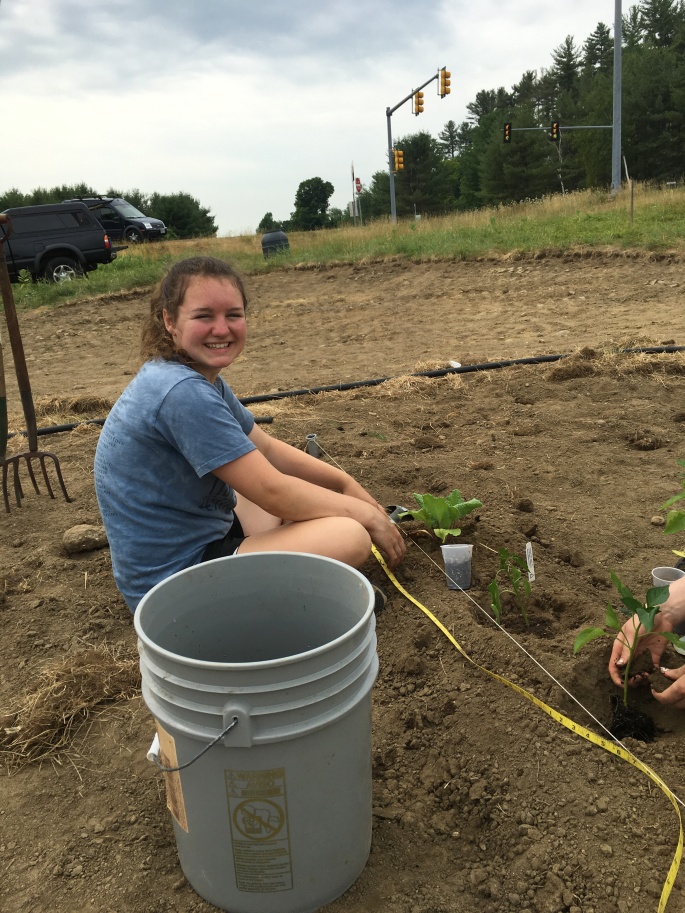Hi, I am Isabelle Laskey-Rigrod, and I was recently hired for the farm to fork fellowship program at the Cornucopia Project. The fellowship program hires students from ConVal high school to gain experience working on implementing the mission of this project. The goal of this fellowship program is to get teens involved with their community, understand roles of leadership, and be aware of the local food system and to be thinking about ways to improve it. There are two other fellows currently employed and more are going to be hired by May. The fellowship’s main work priority is maintaining a hoop house and selling the produce that we grow to local businesses. While, I’ve only worked there for a short amount of time, I feel very passionately about this program and the goals that are to be accomplished.
In the beginning of February when I started work, the first thing on the agenda was the seed order for the summer. The process involved trying to decipher which seeds would work best in our environment, how many of those seeds were needed, and to ensure we stayed in our budget. So after spending a couple of weeks focusing on the seed order, and picking the best varieties of each plant we wanted, an order was finally placed last week. I was unaware of all the small details that had to be factored into a seed order to make this successful. For example, all the math that had to be considered: the amount of seeds per one bed and how many seeds that would fit overall in the hoop house, or the budgeted price we could spend on a specific plant. But, with some help from Hannah, the fellow’s boss, and variety suggestions from Leigh Mae, the process went rather smoothly. After completing that task we focused on hiring new fellows this year. The way the fellowship program works is to employ four students from each grade level to be the fellows for their grade, so when the three senior fellows graduate three more freshman fellows are hired for the next year. This maintains a continuous flow of trained fellows. This past week we completed a presentation that is going to be given to the freshmen that are interested in working at Cornucopia. The presentation will inform them about Cornucopia, and help them to determine whether they would be a good fit as a fellow. We plan on hiring four more fellows for the spring, so that we have seven fellows to work with the hoop house and outdoor garden.
Right now we are preparing the hoop house for the summer. We are also harvesting the winter crop, cleaning out the beds, and starting to plant new seeds for the spring/summer. The summers are the busiest time of the year for the fellows because we have more time to commit to the hoop house.
This summer we are planning to expand from one hoop houses to two, and create another plot outside. This will be very exciting because we can grow more delicious food, and have more healthy plants to sell. This will create more space to grow anything we like – the possibilities are endless.

Our hoop house work day

Its warm enough for worms!

We found some “bad bugs” in the soil too

Our Stir Fry mix

Mache

Working on the freshman presentation in the Cornucopia office








 Hello, my name is Daisy Young, and I am one of the four fellows part of the Farm to Fork fellowship. When I started this fellowship, my intentions were to gain some knowledge about sustainable living and work hands-on with planting. However, it has grown into so much more. Through the beginning process of building the greenhouse, we have started to bring the community together through volunteers and even pure curiosity. Many are talking about the giant carrot and greenhouse by the side of the highway. It’s becoming quite a popular spot! Watching the fruits, vegetables, and herbs that we have planted grow into something more has given me feelings of relief and excitement. So far the program has been a fascinating and great experience that came with new information, relationships, and ideas.
Hello, my name is Daisy Young, and I am one of the four fellows part of the Farm to Fork fellowship. When I started this fellowship, my intentions were to gain some knowledge about sustainable living and work hands-on with planting. However, it has grown into so much more. Through the beginning process of building the greenhouse, we have started to bring the community together through volunteers and even pure curiosity. Many are talking about the giant carrot and greenhouse by the side of the highway. It’s becoming quite a popular spot! Watching the fruits, vegetables, and herbs that we have planted grow into something more has given me feelings of relief and excitement. So far the program has been a fascinating and great experience that came with new information, relationships, and ideas.
